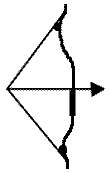"Soundness of method is the only key to reliable performance. " Bobby Jones
Putting at your Highest Level requires that your putting stroke and putter must be designed to work together. In other words, the optimum putter for a straight back and through stroke is an onset center shafted, face balanced putter, and conversely a rotational putting stroke requires an offset, heel-shafted putter. The support for this comes from a clear understanding of putting fundamentals, basic putter design and physics.
The Greats of the Game, Horton Smith, Bobby Locke, Walter Hagen, Bobby Jones, along with Jack Nicklaus and Tiger Woods, utilized many of the following putting fundamentals; 1) shoulders square to the line, 2) ball forward in the stance, 3) weight set to into the left-side, 4) eyes over the line, 5) keep the putter-face square to the line as well as low and level to the ground throughout the putting stroke and 6) stay one-piece (connected) through impact to prevent left-wrist breakdown or flipping.
For consistency, they practiced 7) hooding and 8) arching of the wrists for control of distance and direction and to produce that ground hugging, over-spin roll. They believed 9) the hands should maintain equal but light pressure during the stroke and 10) the sensitivity of the finger tips was very important.
| Bobby Locke | Horton Smith | Ben Crenshaw |
"Hooding" the First Secret in Putting
 |
To fire something, you have to load something. That's what hooding does. it loads the one-piece connection of the left-side (for right handers) and prevents breakdown of the left-side on the follow through. Breakdown of the left-side (the backward bending of the left wrist before impact) is the number one reason golfers are inconsistent in their putting. Hooding also creates the desired over-spin roll that hunts the hole.
In the pictures above, notice where the back of the left hand aims. The farther the backswing, the more it aims down, toward the grass. Actually, the correct hooding action starts from the beginning of the putting stroke. You can always notice poor putters. They slide their hands straight right in their take-away. The result is missed putts. They load nothing, therefore they have nothing to fire. To produce force, they typically flip the putter with their right hand before impact, which causes left-side breakdown and inconsistency.
"Arching" the Second Secret in Putting
| Horton Smith |
The second secret of the putting stroke: arching of the wrists downward. This is a view from behind the hands, looking toward the line of the putt. Note the definite downward curve of the right wrist. "Arching" positions your wrists so that you will tend to utilize only the "back-and-forth" hinges of the wrists.The primary reason that arching of the wrists improves putting consistency is because it limits the up and down motion of the wrists which promotes a better connection of the left-side during the putting stroke.
The full golf swing depends on a two lever system to promote maximum power and distance. The hands are carried low to promote the up and down hinging or setting and the release of the wrists to produce power. However, this causes streaky, inconsistent putting.
In putting, a single lever system produces better control of distance and accuracy. Basically, it is a natural extension of the left-side (for right handers). Notice the downward arching of the wrists in Horton Smith's set-up. This promotes keeping the putter face square to the line throughout the putting stroke and minimizes the tendency for fanning the club open to closed.
Correct Ball Position
Most good putters play the ball forward in their stance. Horton Smith located the ball from off the inside of his left foot. Then he slid the putter forward "square to the line."
| Ball Position is Forward |
According to Jack Nicklaus, the tendency for the ball to be deflected by an irregularity is greater if a ball skids than after it has developed sufficient inertia to roll end over end. A partial solution used by Nicklaus and many touring pros, is to start the ball rolling as early as possible by positioning it a little more forward at address, then striking it just past the bottom of the putter head's arc, or slightly on the upswing.
The tendency for most amateurs is to place the ball more toward the middle of their stance. From a middle position, most often the ball is struck with a descending blow which causes the ball to hop and skid. This defeats the goal of producing an end over end roll.
| PUTTING SUCCESS VIDEOS |
| JUNIOR GOLFERS |
| Start Them Right !! |


